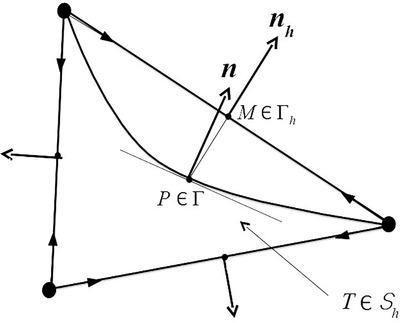Our official English website, www.x-mol.net, welcomes your
feedback! (Note: you will need to create a separate account there.)
Optimal Lagrange and Hermite finite elements for Dirichlet problems in curved domains with straight‐edged triangles
ZAMM - Journal of Applied Mathematics and Mechanics ( IF 2.3 ) Pub Date : 2020-06-30 , DOI: 10.1002/zamm.201900296 Vitoriano Ruas 1, 2
ZAMM - Journal of Applied Mathematics and Mechanics ( IF 2.3 ) Pub Date : 2020-06-30 , DOI: 10.1002/zamm.201900296 Vitoriano Ruas 1, 2
Affiliation

|
One of the reasons for the success of the finite element method in Solid Mechanics, among other Applied Sciences, is its versatility to deal with bodies of arbitrary shape. In case the problem at hand is modeled by second‐order partial differential equations with Dirichlet conditions prescribed on a curvilinear boundary, method's isoparametric version for meshes consisting of curved triangles or tetrahedra has been mostly employed to recover the optimal approximation properties known to hold for polygonal or polyhedral domains and methods of order greater than one based on standard straight‐edged elements. However, besides algebraic and geometric inconveniences, the isoparametric technique is limited in scope, since its extension to degrees of freedom other than function values is not straightforward. In previous work the author introduced a simple alternative, which bypasses the above drawbacks without eroding qualitative approximation properties. Among other advantages, it can do without curved elements and is based only on polynomial Algebra. The purpose of this paper is two‐fold: On the one hand the mathematical foundations of this method are established, in the framework of a model Poisson problem solved with Lagrange elements; in particular optimal‐rate error estimates both in energy norm and in the mean‐square sense are demonstrated and a numerical comparison with the isoparametric technique is carried out. On the other hand this study is extended to Hermite elements with normal‐derivative degrees of freedom for solving the equation modeling the bending of clamped thin plates with a curvilinear edge.
中文翻译:

直角三角形曲线区域中Dirichlet问题的最优Lagrange和Hermite有限元
包括其他应用科学在内的固体力学中的有限元方法成功的原因之一是它能够处理任意形状的物体。如果当前问题是通过在曲线边界上规定Dirichlet条件的二阶偏微分方程建模的,则对于由弯曲三角形或四面体组成的网格,该方法的等参形式通常用于恢复已知对多边形具有的最佳逼近性质或多面体域以及基于标准直边元素的阶数大于一的方法。但是,除了代数和几何上的不便外,等参技术的范围也受到限制,因为它无法扩展到除函数值之外的自由度。在先前的工作中,作者介绍了一种简单的替代方法,该替代方法绕过了上述缺点,而没有侵蚀定性近似属性。除其他优点外,它可以不使用弯曲元素,并且仅基于多项式代数。本文的目的有两个方面:一方面,在使用拉格朗日元素求解的泊松模型模型的框架中,建立了该方法的数学基础;尤其是在能量范数和均方意义上均展示了最佳速率误差估计,并与等参技术进行了数值比较。另一方面,该研究扩展到具有法向导数自由度的Hermite元素,用于求解模拟具有曲线边缘的夹紧薄板弯曲的方程。绕过了以上缺点,而没有侵蚀定性近似性质。除其他优点外,它可以不使用弯曲元素,并且仅基于多项式代数。本文的目的有两个方面:一方面,在使用拉格朗日元素求解的泊松模型模型的框架中,建立了该方法的数学基础;特别是在能量范数和均方意义上都证明了最佳速率误差估计,并与等参技术进行了数值比较。另一方面,该研究扩展到具有法向导数自由度的Hermite元素,用于求解模拟具有曲线边缘的夹紧薄板弯曲的方程。绕过了以上缺点,而没有侵蚀定性近似性质。除其他优点外,它可以不使用弯曲元素,并且仅基于多项式代数。本文的目的有两个方面:一方面,在使用拉格朗日元素求解的泊松模型模型的框架中,建立了该方法的数学基础;特别是在能量范数和均方意义上都证明了最佳速率误差估计,并与等参技术进行了数值比较。另一方面,该研究扩展到具有法向导数自由度的Hermite元素,用于求解模拟具有曲线边缘的夹紧薄板弯曲的方程。它可以不使用弯曲元素,并且仅基于多项式代数。本文的目的有两个方面:一方面,在使用拉格朗日元素求解的泊松模型模型的框架中,建立了该方法的数学基础;特别是在能量范数和均方意义上都证明了最佳速率误差估计,并与等参技术进行了数值比较。另一方面,该研究扩展到具有法向导数自由度的Hermite元素,用于求解模拟具有曲线边缘的夹紧薄板弯曲的方程。它可以不使用弯曲元素,并且仅基于多项式代数。本文的目的有两个方面:一方面,在使用拉格朗日元素求解的泊松模型模型的框架中,建立了该方法的数学基础;特别是在能量范数和均方意义上都证明了最佳速率误差估计,并与等参技术进行了数值比较。另一方面,该研究扩展到具有法向导数自由度的Hermite元素,用于求解模拟具有曲线边缘的夹紧薄板弯曲的方程。在用拉格朗日元素解决的模型泊松问题的框架中;特别是在能量范数和均方意义上都证明了最佳速率误差估计,并与等参技术进行了数值比较。另一方面,该研究扩展到具有法向导数自由度的Hermite元素,用于求解模拟具有曲线边缘的夹紧薄板弯曲的方程。在用拉格朗日元素解决的模型泊松问题的框架中;尤其是在能量范数和均方意义上均展示了最佳速率误差估计,并与等参技术进行了数值比较。另一方面,该研究扩展到具有法向导数自由度的Hermite元素,用于求解模拟具有曲线边缘的夹紧薄板弯曲的方程。
更新日期:2020-06-30
中文翻译:

直角三角形曲线区域中Dirichlet问题的最优Lagrange和Hermite有限元
包括其他应用科学在内的固体力学中的有限元方法成功的原因之一是它能够处理任意形状的物体。如果当前问题是通过在曲线边界上规定Dirichlet条件的二阶偏微分方程建模的,则对于由弯曲三角形或四面体组成的网格,该方法的等参形式通常用于恢复已知对多边形具有的最佳逼近性质或多面体域以及基于标准直边元素的阶数大于一的方法。但是,除了代数和几何上的不便外,等参技术的范围也受到限制,因为它无法扩展到除函数值之外的自由度。在先前的工作中,作者介绍了一种简单的替代方法,该替代方法绕过了上述缺点,而没有侵蚀定性近似属性。除其他优点外,它可以不使用弯曲元素,并且仅基于多项式代数。本文的目的有两个方面:一方面,在使用拉格朗日元素求解的泊松模型模型的框架中,建立了该方法的数学基础;尤其是在能量范数和均方意义上均展示了最佳速率误差估计,并与等参技术进行了数值比较。另一方面,该研究扩展到具有法向导数自由度的Hermite元素,用于求解模拟具有曲线边缘的夹紧薄板弯曲的方程。绕过了以上缺点,而没有侵蚀定性近似性质。除其他优点外,它可以不使用弯曲元素,并且仅基于多项式代数。本文的目的有两个方面:一方面,在使用拉格朗日元素求解的泊松模型模型的框架中,建立了该方法的数学基础;特别是在能量范数和均方意义上都证明了最佳速率误差估计,并与等参技术进行了数值比较。另一方面,该研究扩展到具有法向导数自由度的Hermite元素,用于求解模拟具有曲线边缘的夹紧薄板弯曲的方程。绕过了以上缺点,而没有侵蚀定性近似性质。除其他优点外,它可以不使用弯曲元素,并且仅基于多项式代数。本文的目的有两个方面:一方面,在使用拉格朗日元素求解的泊松模型模型的框架中,建立了该方法的数学基础;特别是在能量范数和均方意义上都证明了最佳速率误差估计,并与等参技术进行了数值比较。另一方面,该研究扩展到具有法向导数自由度的Hermite元素,用于求解模拟具有曲线边缘的夹紧薄板弯曲的方程。它可以不使用弯曲元素,并且仅基于多项式代数。本文的目的有两个方面:一方面,在使用拉格朗日元素求解的泊松模型模型的框架中,建立了该方法的数学基础;特别是在能量范数和均方意义上都证明了最佳速率误差估计,并与等参技术进行了数值比较。另一方面,该研究扩展到具有法向导数自由度的Hermite元素,用于求解模拟具有曲线边缘的夹紧薄板弯曲的方程。它可以不使用弯曲元素,并且仅基于多项式代数。本文的目的有两个方面:一方面,在使用拉格朗日元素求解的泊松模型模型的框架中,建立了该方法的数学基础;特别是在能量范数和均方意义上都证明了最佳速率误差估计,并与等参技术进行了数值比较。另一方面,该研究扩展到具有法向导数自由度的Hermite元素,用于求解模拟具有曲线边缘的夹紧薄板弯曲的方程。在用拉格朗日元素解决的模型泊松问题的框架中;特别是在能量范数和均方意义上都证明了最佳速率误差估计,并与等参技术进行了数值比较。另一方面,该研究扩展到具有法向导数自由度的Hermite元素,用于求解模拟具有曲线边缘的夹紧薄板弯曲的方程。在用拉格朗日元素解决的模型泊松问题的框架中;尤其是在能量范数和均方意义上均展示了最佳速率误差估计,并与等参技术进行了数值比较。另一方面,该研究扩展到具有法向导数自由度的Hermite元素,用于求解模拟具有曲线边缘的夹紧薄板弯曲的方程。











































 京公网安备 11010802027423号
京公网安备 11010802027423号